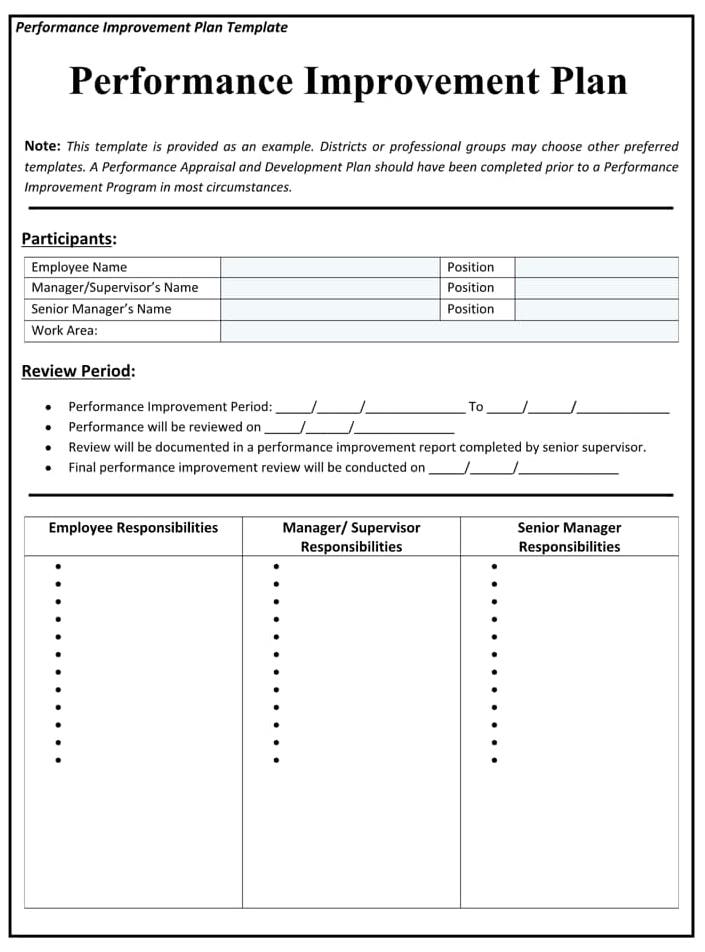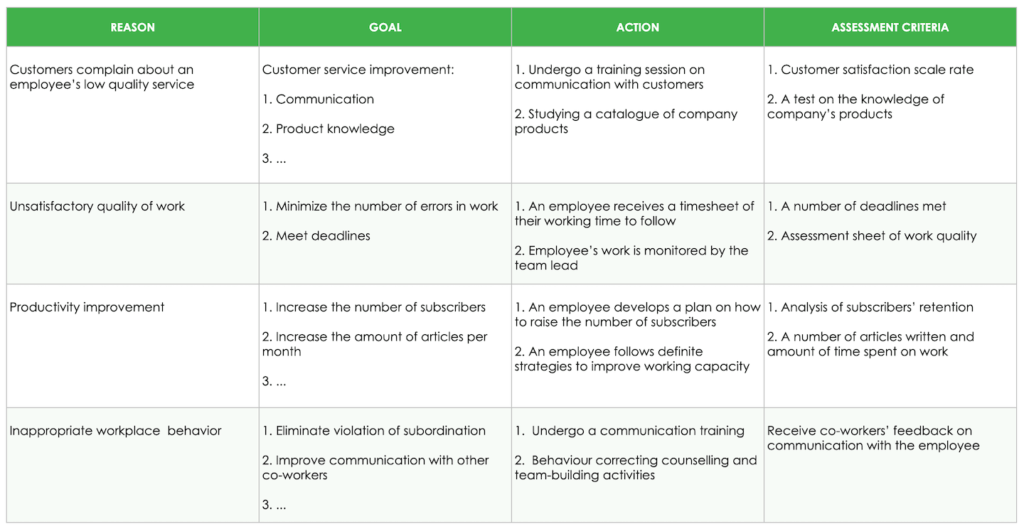Work performance is never a stable thing. Sometimes you can show outstanding results but other days you lose in the productivity stakes. The same applies to your employees – we’re all human after all. But, if poor performance becomes a regular occurrence for your employees and even the best time tracking software doesn’t help, you might consider a performance improvement plan.
In this article, you will learn what a performance improvement plan is, how to compile a great one, and how to implement it effectively to get the results you need.
Understanding Performance Improvement Plans (PIPs)
A performance improvement plan (PIP) is a tool for helping underperforming employees succeed by addressing job goal failures or behavioral issues. It gives employees with performance failures an opportunity to meet job goals and fix all the issues arising in a work process.

A performance improvement plan:
- is developed and approved by the employee’s manager and HR
- clearly states the steps an employee should take to improve their performance
- has definite goals and a deadline (30, 60, or 90 days)
- explains the implications (demotion, dismissal, or transfer to another department) should the employee fail to meet the requirements listed in PIP
- can be used for legal scrutiny in case a company and an employee don’t find common ground on work-related issues
When and How to Use a PIP Effectively
Employees tend to treat performance improvement plans rather negatively 😡 and often consider them as an informal invitation for termination or demotion. When implementing a PIP, use caution. This decision needs to be well-thought-out. For this, HR needs to:
- determine if a PIP is really required in this case
- avoid any bias implication that may occur during employee’s performance monitoring
- provide support to the employee and their manager alongside the plan implementation
- state clear goals, performance assessment criteria, and deadlines in the PIP
Examples for Applying a Performance Improvement Plan
Here are several examples of when a performance improvement plan can be applied:
Steps to Create a Successful Performance Improvement Plan
Now, that you know some of the reasons for a performance improvement plan, let’s discover how to create the most effective ones.
A performance improvement plan is usually a formal, confidential document not more than two pages long. It’s written by HR, with the approval of the manager, and agreement with the employee. Here are the stages of how to do it well.
Creating a Performance Improvement Plan
Stage 1: Define the problem
At this stage, you need to understand precisely what an employee is doing wrong that adversely affects their performance. These negative points should be well defined and include examples of poor work or behavior. Not just feelings or thoughts.
You can also realize if you truly need a PIP at this point. A good thing to do is to call your employee in for a chat and determine together:
- what’s wrong with the employee’s performance
- which parts could be improved
- how to improve their work and behavior
This way you’ll encourage the employee to participate in their improvement and they will feel more committed to it. In addition, it’ll be easier to understand the reason for the employee’s poor performance. These can be different – starting from feeling too much pressure to unmet expectations and ending in personal problems at home.
Give your workers a chance to be heard. Maybe a simple change in working schedule or some time-off work will change the situation dramatically.
Stage 2: Determine the objectives
If you’ve defined the performance problems but a chat about improvement had no impact, then it’s time to set the objectives for your PIP. The easiest and most effective way to create workable objectives is to use the SMART framework. Meaning that your objectives should be:
- S for specific. They have tangible outcomes and definite numbers and dates
- M for measurable. They can be estimated and tracked
- A for attainable. They should be challenging but achievable
- R for relevant. They should be valuable for an employee
- T for time-bound. They have deadlines and check-in sessions
When creating a PIP, it’s worthwhile communicating with all the participants involved directly or indirectly in the improvement process. Discuss the situation of the employee’s performance not only with them and the manager but with all the possible parties concerned, within reason. Remember, certain issues are related to confidentiality. This will give you a deeper understanding of the issue and help avoid any bias on employees’ work.
Stage 3: Provide support
At this stage, you need to define the possible steps that the employee should take to achieve their objectives. Consider what kind of support you could provide to the employee. For example, a list of available resources they can use, such as a manager’s assistance, training, and sources of additional information.
Make sure your employee feels the support of their team. Think about the improvements the employee could make with the help of their co-workers. Encourage communication and readiness to help among team members.
For effective self-organization, you can suggest the employee uses time-management tips or helpful mini-apps to significantly ease working processes.
Stage 4: Set up a schedule and interim check-ins
When all the performance improvement plan objectives and steps are specified, it’s time to determine the key dates to monitor the outcomes.
Arrange meetings with your employee at regular intervals, before the deadlines. Providing interim result feedback contributes to more effective work on errors. You’ll be better able to correct and guide the employee’s development along with the PIP objectives and achievements and help them self-correct before the deadline.
Automate your schedule with a handy time-tracking app. Keep yourself and your employee informed on the upcoming tasks and deadlines.
Stage 5: Point out the consequences
Elaborate on the consequences the employee will meet if there is a failure to fulfill the performance improvement plan objectives. This stage is rather touchy, as you state the negative after-effects that follow PIP’s failure. Therefore you need to make sure that the employee understands:
- the reason you implemented a PIP
- the steps the employee should follow to fulfill PIP objectives successfully
- who the employee should refer to for help and advice
- what are the deadlines and check-in sessions
When assessing the employee’s work, it’s worth concentrating not only on the errors made but also on the positive contributions and achieved goals that they made. It shows the path the employee can use to improve their performance, and that their effort is valued.
Performance Improvement Plan – Elements
You already know the stages you should follow when writing a performance improvement plan. Let’s have a look at its structure.
Generally, employee performance improvement plan worksheets do not differ much from company to company in their structure. Meaning that if you download or follow a standard template it won’t differ much from the performance improvement plans of IBM, Google, or Amazon.
The only thing you need to consider before creating a performance improvement plan is that it can vary in the number of days usually from 30, 60 to 90 days. So, what to include in your performance improvement plan:
Part 1: Stakeholders
This part should include everyone involved in the improvement process. They can be supervisors, managers, HRs, co-workers, and employees. Remember to mention their names, positions, and departments in the company.
Part 2: Dates
The dates should include:
- when the document was created
- when the meeting with the employee was arranged
- deadlines and check-in dates.
Part 3: Current quality performance
Describe in detail:
- what problems the employee is experiencing in their work
- if there were any meetings or discussions on work quality organized previously
- the workflow processes that require improvement and what kind of improvement it should be
- any previous training or coaching that employees had to improve their performance.
Part 4: Improvement objectives
List the objectives that have definite measurable criteria and certain deadlines. They should be achievable and valuable for the employee.
Part 5: Support, resources, and extra information
This part should include:
- the list of the people the employee can refer to for help
- resources the employee can use for performance improvements, such as coaching or pieces of training
- extra materials and outside sources the employee can use on their own to improve their work
Part 6: Performance improvement plan outcomes
Include the definite outcomes you expect from the employee by the expiry date of the performance improvement plan. In this part, you need to add the negative consequences the employee can have if they fail to meet the PIP deadlines or PIP objectives.
Part 7: Action steps and timetable
This part should contain:
- the steps the employee should take to fulfill the PIP objectives
- the schedule for revision of each objective completion
- PIP start and end dates
Part 8: Signatures
Include the signatures of all the parties involved to ensure they agree to the steps laid out in the plan.
Performance Improvement Plan – Sample Letter ✉️
A performance improvement plan is usually sent in the form of a letter after a discussion with the employee at a meeting.
Here is a sample of a standard performance improvement letter:
To: (employee’s name)
From: (your name)
Subject: Performance Improvement Plan (date)
This letter represents a Performance Improvement Plan (date of creation) with a focus on improving your performance at work in the areas listed below.
- Current quality performance
- Improvement objectives
- Acting steps
- Performance improvement outcomes
- Interim check-in
- Final deadline
The Performance Improvement Plan shall take effect on (date) and the final meeting on the performance improvement outcomes will be on (date).
In the case that the Performance Improvement Plan objectives are not met by the deadline, the company will have to (state the consequences).
My supervisor has discussed and explained the following Performance Improvement Plan to me. I understand and acknowledge the contents and realize the potential consequences.
(Employee’s name)
(Signature and date)
The Performance Improvement Plan was revised and approved by:
(Supervisor’s name)
(Signature and date)
(Manager’s name)
(Signature and date)
(HR’s name)
(Signature and date)(and check out our list of the best e-signature apps btw)
How to Respond to a Performance Improvement Plan
If you’re the person who’s received the performance improvement plan, there’s no need to panic and constantly ask yourself “Should I quit?”. The answer is “Absolutely, NO!” What you really should do is to look at the situation from a different perspective.
A performance improvement plan is a great opportunity for you to prove yourself and save the day (and your job). A PIP is a sign that the company isn’t ready to quietly terminate your contract but wants to give you a chance to improve the situation, spending its sources on your training and education.
What Are the Benefits You Can Get From Pip as an Employee?
- Get your manager’s support and work review, meaning that you can improve the parts of your performance you might have not understood at the beginning and get some more work experience.
- As your possible mistakes are corrected precisely, you can develop into a highly-skilled specialist, meaning that you may even be able to land that promotion in the future if you do everything right.
- If you have no time for extra studies, this is the time to take up training provided by the company and upgrade your skill level.
- Sometimes when an emergency situation happens, such as a PIP, we act contrary to our usual behavior. This method of action can help expand our career horizons. If you are a shy person, then PIP can push you towards communication with your co-workers and even giving speeches in front of the public.
Heading for a PIP? Here’s What you Can do to Improve in Advance
- Organize your routine. It’ll make you more concentrated and significantly boost your productivity.
- Use timesheets and calendars. When you prioritize and systemize your tasks, you become able to do more in one day and as a result, have more time for rest.
- Use a handy time tracker. By integrating apps in your browser or everyday tools you use at work, you can estimate your working time and time-off work. You’ll understand how to allocate it better.
- Don’t stress too much and learn something new.
Take Away
A performance improvement plan means that your company wants to help you improve your work rather than just push you towards resignation. Take this as the opportunity it is to improve and make sure your employee sees it that way too.
Implementing a performance improvement plan requires lots of work from all the parties involved:
- The manager and HR should reflect deeply on the PIP and develop it in detail.
- The employee should monitor the time and follow all the PIP’s steps to meet its objectives successfully.
- The manager or supervisor and HR should monitor, help and correct the employee’s actions on the way to their improvement.
- The employee, the manager, HR, and all the parties involved should be ready to meet the outcomes and consequences whether it’s a success or failure of the PIP.
Using a performance improvement plan can be a strong and helpful motivator for an employee to develop their skills and improve performance at work. Focus on how it can boost performance and less on the threat of dismissal, centering the plan around the negative dooms it to failure. When performance appraisals identify areas of improvement, an aligned performance improvement plan can guide employees toward clear, achievable goals, ultimately benefiting both the employee and the organization.
If you are managing a team of 5 or more and looking to boost efficiency, Everhour is the perfect tool to keep your team on track. With seamless time tracking, you can easily estimate task durations, set clear budgets, and generate detailed reports inside Asana, Trello, Jira, or any other pm tool.


